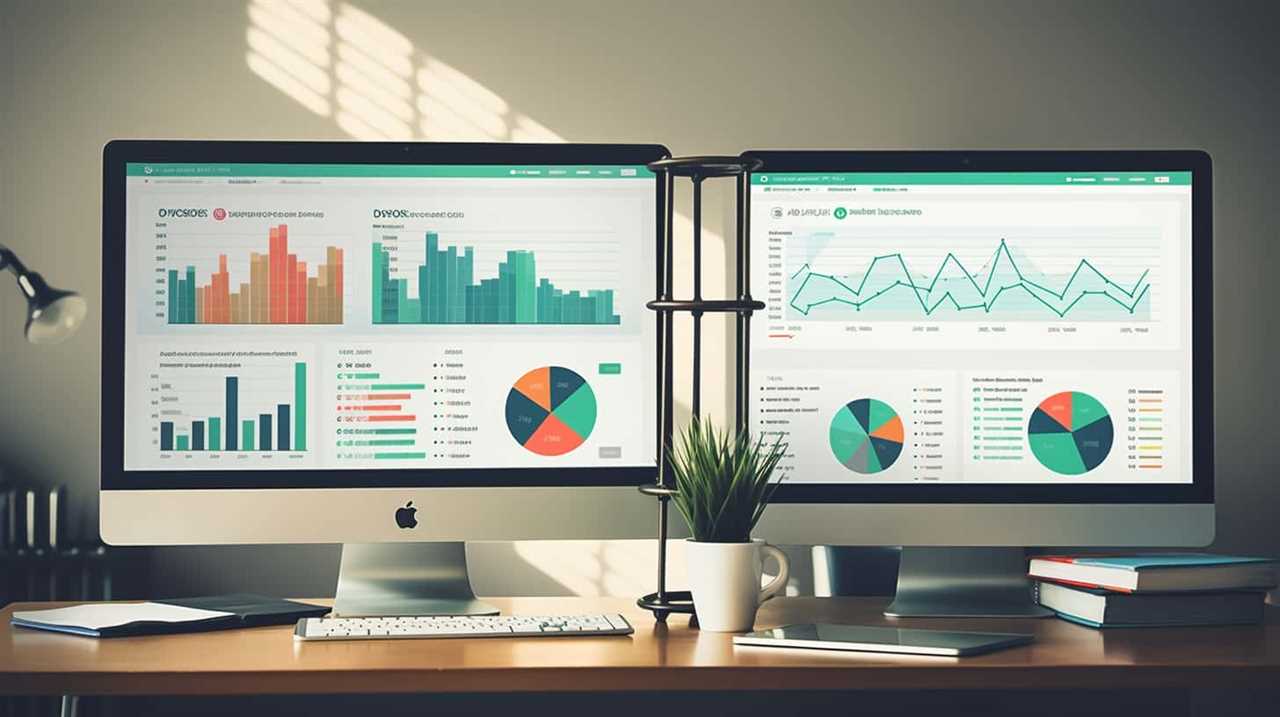Are you ready to take your construction or renovation company’s internet presence to the next level?
We’ve got the ultimate guide for you!
With our strategic and data-driven approach, we’ll show you how to optimize your website for search engines and attract targeted traffic like never before.
From conducting keyword research to creating engaging content, we’ll equip you with the tools to dominate the online world.

Get ready to master SEO and watch your business thrive!
Key Takeaways
- Conduct competitor analysis to gain insights and identify areas for improvement.
- Optimize meta tags with relevant keywords and compelling descriptions.
- Implement SEO strategies to enhance online presence and attract qualified leads.
- Utilize local SEO tactics to target specific geographic areas.
Understanding SEO for Construction Companies
In this section, we’ll explore the importance of SEO for construction companies and how it can significantly impact their online presence. As construction companies continue to compete in the digital landscape, understanding the fundamentals of SEO is crucial for achieving success.
One key aspect of SEO for construction companies is conducting competitor analysis. By analyzing the SEO strategies of your competitors, you can gain valuable insights into what’s working in your industry and identify areas for improvement. This analysis allows you to stay one step ahead of your competitors and make informed decisions when optimizing your own website.
Another important element of SEO is optimizing meta tags. Meta tags are HTML elements that provide information about a web page to search engines. By optimizing your meta tags with relevant keywords and compelling descriptions, you can improve your website’s visibility in search engine results pages. This not only attracts more organic traffic but also increases the chances of users clicking on your website.

In conclusion, conducting competitor analysis and optimizing meta tags are essential components of SEO for construction companies. By implementing these strategies, you can enhance your online presence, attract more qualified leads, and ultimately achieve business growth.
Stay tuned for the next section, where we’ll dive deeper into the world of SEO for construction and renovation companies.
Importance of Online Presence for Renovation Businesses
To understand the significance of online presence for renovation businesses, let’s continue our exploration of SEO strategies and how they can enhance visibility and attract potential clients.
In today’s digital age, it’s crucial for renovation businesses to establish a strong online presence. Here are a few reasons why:

- Importance of online reviews: Online reviews are a powerful tool for attracting new clients. Positive reviews not only build credibility but also act as social proof, showing potential clients that your renovation business is trustworthy and delivers quality work.
- Building a strong brand identity: An online presence allows renovation businesses to showcase their unique brand identity. Through a well-designed website and engaging social media profiles, you can convey your company’s values, expertise, and style. This helps you stand out from the competition and attract clients who resonate with your brand.
- Increased visibility: A strong online presence increases your visibility in search engine results. By optimizing your website for relevant keywords and using SEO techniques, you can improve your rankings and appear higher in search results. This makes it easier for potential clients to find your business when they’re actively searching for renovation services.
- Attracting targeted traffic: An online presence allows you to target specific demographics and attract the right audience for your renovation business. By creating valuable content, optimizing for relevant keywords, and utilizing social media advertising, you can drive targeted traffic to your website and increase the chances of converting visitors into clients.
In the next section, we’ll explore the importance of conducting keyword research for targeted traffic and how it can further enhance your online presence.
Conducting Keyword Research for Targeted Traffic
We conduct keyword research to identify the most relevant and high-performing keywords for attracting targeted traffic to our construction and renovation company’s online presence. Keyword research is a crucial step in our SEO strategy as it helps us understand what our potential customers are searching for and allows us to optimize our website accordingly.
To effectively conduct keyword research, we utilize various tools and techniques. One of the first steps is to brainstorm a list of relevant keywords and phrases related to our industry. We then use keyword research tools to analyze the search volume and competition for each keyword. This helps us prioritize which keywords to target based on their potential to drive traffic to our website.
Additionally, we consider the intent behind each keyword. Are users searching for information, products, or services? Understanding user intent allows us to create relevant and valuable content that matches their needs.

To illustrate the importance of keyword research, here’s a table showcasing the search volume and competition for two keywords related to our industry:
| Keyword | Search Volume | Competition |
|---|---|---|
| Improving website architecture | 1,000 | Low |
| Optimizing meta tags | 2,500 | Medium |
By targeting keywords like "improving website architecture" and "optimizing meta tags," we can attract a significant amount of targeted traffic to our website.
In the next section, we will explore the importance of optimizing on-page SEO for construction websites and how it can further enhance our online presence and visibility.
Optimizing On-Page SEO for Construction Websites
Continuing from our previous discussion on conducting keyword research, let’s now delve into optimizing on-page SEO for construction websites to further enhance our online presence and visibility.

When it comes to keyword optimization, it’s crucial to strategically incorporate relevant keywords throughout your website’s content. Here are a few key steps to optimize your on-page SEO:
- Keyword Research: Begin by identifying the most relevant and high-performing keywords in your industry. Use tools like Google Keyword Planner or SEMrush to find keywords that have high search volume and low competition.
- Title Tags and Meta Descriptions: Craft compelling and keyword-rich title tags and meta descriptions for each page of your website. These elements appear in search engine results and play a crucial role in attracting potential visitors.
- URL Optimization: Ensure that your website’s URLs are structured in a way that includes relevant keywords. This helps search engines understand the content on your pages and improves your chances of ranking higher in search results.
- Heading Tags and Content Optimization: Use heading tags (H1, H2, H3) to structure your content and include keywords naturally. Additionally, optimize your content by incorporating relevant keywords throughout the text, but be sure to maintain readability and avoid keyword stuffing.
Creating Engaging Content for Improved SEO
As we delve into the subtopic of creating engaging content for improved SEO in our discussion on building an online presence for construction and renovation companies, it is important to understand the significance of incorporating interactive elements into your website. By enhancing user engagement and increasing website visibility through content, you can effectively attract and retain your target audience.
One effective way to improve user engagement is by utilizing interactive features such as quizzes, polls, and surveys. These elements not only encourage visitors to actively participate, but they also provide valuable insights into their preferences and needs. By gathering this data, you can tailor your content to better meet their expectations, ultimately leading to increased engagement and conversions.
Another strategy to consider is incorporating visual content, such as videos and infographics. These visually appealing elements not only grab attention but also convey information in a more digestible and memorable way. Research has shown that visual content tends to generate higher engagement and shareability, resulting in increased website visibility.

To further enhance user engagement, it is crucial to deliver high-quality and relevant content. This can be achieved by conducting keyword research to identify popular topics and optimize your content accordingly. Additionally, regularly updating your website with fresh and informative content will keep visitors coming back for more.
To summarize, creating engaging content is vital for improving SEO and building an online presence for construction and renovation companies. By incorporating interactive elements, visual content, and delivering high-quality information, you can effectively increase user engagement and enhance website visibility.
| Key Points | Benefits |
|---|---|
| Utilize interactive features | Encourages active participation and provides valuable insights |
| Incorporate visual content | Grabs attention and conveys information effectively |
| Deliver high-quality and relevant content | Increases website relevance and attracts repeat visitors |
| Regularly update website | Keeps visitors engaged and coming back for more |
| Conduct keyword research | Optimizes content for popular topics and improves search rankings |
Leveraging Local SEO for Construction and Renovation Services
When it comes to construction and renovation services, targeting the local customer base is crucial for success. By leveraging local SEO strategies, construction and renovation companies can optimize their online presence to appear in local search results.
This means focusing on location-specific keywords, creating local business listings, and obtaining positive customer reviews to boost visibility and attract local customers in need of their services.

Targeting Local Customer Base
Optimizing our website for local search results is crucial for attracting potential customers in the construction and renovation industry. By implementing effective local marketing strategies and targeting specific neighborhoods, we can increase our visibility and reach within our local customer base.
Here are four key ways to leverage local SEO for construction and renovation services:
- Conduct thorough keyword research to identify the most relevant and high-volume search terms used by potential customers in our target area.
- Optimize our website content and meta tags with location-specific keywords to improve our ranking in local search results.
- Create and optimize our Google My Business profile to enhance our visibility in Google Maps and local search results.
- Encourage online reviews and testimonials from satisfied customers to build trust and credibility with the local community.
Optimizing Local Search Results
We actively leverage local SEO strategies to optimize our construction and renovation services for local search results. Local search optimization is crucial for improving online visibility and attracting potential customers in our target area. By implementing effective local SEO techniques, we can ensure that our business appears prominently in local search results, increasing our chances of being discovered by local customers who are actively seeking our services.
To further illustrate the importance of local search optimization, let’s take a look at the following table:

| Local SEO Strategy | Benefits | Examples |
|---|---|---|
| Google My Business | Increased visibility and credibility | Claiming and optimizing our Google My Business profile. |
| Local keyword research | Targeted content creation | Identifying and incorporating local keywords in our website content. |
| Online directories | Enhanced online presence | Listing our business in relevant online directories such as Yelp and Angie’s List. |
Building High-Quality Backlinks for SEO Success
To consistently improve our website’s search engine rankings, it’s crucial for us to actively acquire high-quality backlinks. Building backlinks from reputable sources not only boosts our website’s authority, but it also enhances our visibility in search engine results pages (SERPs).
Here are some effective strategies for building high-quality backlinks:
- Guest Blogging: By writing informative and valuable content for other websites in our industry, we can include a link back to our website in the author bio or within the content itself. This not only helps us reach a wider audience but also establishes us as an expert in our field.
- Influencer Partnerships: Collaborating with influencers in the construction and renovation industry can significantly boost our online presence. By partnering with influencers for sponsored content or product reviews, we can gain exposure to their loyal followers and potentially earn valuable backlinks.
- Content Outreach: Creating exceptional content is just the first step. To maximize the impact of our content, we need to actively promote it. By reaching out to industry influencers and relevant websites, we can increase the chances of them linking to our content.
- Broken Link Building: This strategy involves finding broken links on other websites and offering our own content as a replacement. Not only does this help the website owner fix broken links, but it also provides us with an opportunity to earn a high-quality backlink.
Utilizing Social Media for Construction and Renovation Marketing
Utilizing social media platforms is an essential aspect of our construction and renovation marketing strategy. In today’s digital age, social media has become a powerful tool for connecting with potential customers, building brand awareness, and driving traffic to our website. To help you understand the impact of social media on our marketing efforts, let’s take a closer look at some effective social media marketing strategies and how we measure social media ROI.
| Social Media Platform | Strategy | Measurement |
|---|---|---|
| Create engaging content and share project updates, before-and-after photos, and testimonials. | Track engagement metrics such as likes, comments, and shares, as well as website traffic and conversions from Facebook. | |
| Showcase visually appealing images and videos of our projects, including behind-the-scenes footage. | Monitor follower growth, post reach, and engagement rates. Measure traffic and conversions from Instagram using tracking links. | |
| Establish thought leadership by sharing industry insights, project success stories, and connecting with industry professionals. | Track engagement metrics such as likes, comments, and shares. Measure website traffic and conversions from LinkedIn using UTM parameters. | |
| YouTube | Create informative videos about construction and renovation tips, project showcases, and client testimonials. | Monitor views, likes, comments, and shares. Measure website traffic and conversions from YouTube using tracking links. |
Implementing Mobile-Friendly Design for Enhanced User Experience
When it comes to building an effective online presence, implementing a mobile-friendly design is crucial for providing an enhanced user experience. Responsive website design ensures that your site adapts seamlessly to different screen sizes, allowing users to easily navigate and access your content on any device.

Additionally, optimizing the speed and performance of your website is essential for reducing load times and keeping users engaged. By prioritizing mobile-friendliness and optimizing performance, you can create a user-friendly experience that boosts your online visibility and drives more conversions.
Responsive Website Design
We implemented mobile-friendly design to enhance the user experience on our construction and renovation company’s website. This responsive website design ensures that our site is easily accessible and navigable on various devices, including smartphones and tablets.
Here are four key benefits of implementing mobile-friendly design:
- Improved user experience: With responsive design, our website adjusts to fit different screen sizes, providing a seamless and enjoyable browsing experience for our users.
- Increased mobile traffic: As more people use mobile devices to browse the internet, having a mobile-friendly website helps us attract and retain mobile users, leading to increased traffic and potential customers.
- Higher search engine rankings: Responsive design is favored by search engines, and having a mobile-friendly website can improve our search engine optimization efforts, helping us rank higher in search results.
- Better conversion rates: When our website is easy to use and navigate on mobile devices, it increases the likelihood of users converting into customers.
By implementing responsive website design with user-friendly navigation, we’ve set the foundation for an exceptional online experience.

Now, let’s explore the next crucial aspect: speed and performance optimization.
Speed and Performance Optimization
To further enhance the user experience, we focus on optimizing the speed and performance of our mobile-friendly website.
One key aspect of this optimization is image compression. By compressing our images, we reduce their file size without compromising their quality. This not only helps our website load faster but also ensures that users can view our images seamlessly on their mobile devices.
Additionally, we implement browser caching, which allows our website’s static files to be stored in a user’s browser. This means that when a user revisits our website, the browser can retrieve these files from the cache instead of downloading them again. This significantly improves loading times and contributes to a smoother user experience.

Tracking and Analyzing SEO Metrics for Continuous Improvement
To effectively improve our SEO strategies, construction and renovation companies must track and analyze a variety of metrics. By tracking website performance and analyzing our competition’s SEO strategies, we can gain valuable insights and make data-driven decisions to continuously improve our online presence. Here are some key metrics that we should focus on:
- Keyword Rankings: Monitoring our website’s rankings for targeted keywords will help us understand how well our SEO efforts are performing and identify areas for improvement.
- Organic Traffic: Tracking the amount of organic traffic coming to our website will give us an indication of our website’s visibility in search engine results pages (SERPs).
- Conversion Rate: Analyzing the conversion rate of our website will help us determine how effective our SEO strategies are in driving valuable actions, such as submitting a contact form or making a purchase.
- Backlink Profile: Examining the quality and quantity of backlinks pointing to our website will allow us to assess our link building efforts and identify opportunities for acquiring high-quality backlinks.
By regularly monitoring and analyzing these metrics, we can identify areas of improvement, optimize our SEO strategies, and ultimately drive more targeted traffic to our construction and renovation websites.
To further enhance our online presence, it’s crucial to optimize images and videos on our construction and renovation websites.
Optimizing Images and Videos for Construction and Renovation Websites
When it comes to optimizing images and videos for construction and renovation websites, there are a few key points to consider.

First, choosing the right image file format can greatly impact load times and user experience.
Additionally, adding descriptive alt text to your images not only improves accessibility, but also provides valuable context for search engines.
Lastly, optimizing video loading speed is crucial for reducing bounce rates and keeping visitors engaged.
Image File Formats
Optimizing images and videos plays a crucial role in enhancing the online presence of construction and renovation companies. When it comes to image file formats, understanding the differences between JPEG and PNG, as well as GIF and WebP, is essential for maximizing website performance.

Here are some key points to consider:
- JPEG vs PNG: JPEG is ideal for photographs and complex images, as it offers high compression without significant loss of quality. On the other hand, PNG is best for images with transparent backgrounds or simple graphics, as it supports lossless compression.
- GIF vs WebP: GIF is commonly used for animations and simple graphics, but it has limited color support and larger file sizes. WebP, on the other hand, offers better compression and superior image quality, making it a great choice for both static and animated images.
Alt Text Importance
We prioritize optimizing images and videos for construction and renovation websites by incorporating alt text.
Alt text, or alternative text, is a crucial component in website accessibility, ensuring that visually impaired users can understand the content of an image or video through screen readers.
When writing alt text, it’s important to follow best practices to provide accurate and descriptive information.

Firstly, be concise and specific, using keywords that accurately describe the image or video.
Secondly, avoid using phrases like ‘image of’ or ‘picture of,’ as screen readers already announce that it’s an image.
Finally, prioritize the most important information in the alt text, focusing on the context and purpose of the image or video.
Video Loading Speed
To improve the overall user experience and accessibility of our construction and renovation websites, it’s essential to prioritize video loading speed and optimize images and videos.

Slow loading videos can lead to frustration and high bounce rates, resulting in lost opportunities for engagement and conversions. By optimizing video loading speed, we can ensure that our website visitors have a seamless and enjoyable browsing experience.
Here are some strategies to improve video loading speed:
- Compress videos: Reduce file sizes without compromising quality.
- Use responsive video players: Adapt to different device screens for optimal viewing.
- Enable lazy loading: Load videos only when they’re visible to the user.
- Utilize video hosting platforms: Leverage the capabilities of platforms like YouTube or Vimeo for faster loading times.
Implementing these video SEO strategies won’t only improve the loading speed of videos but also enhance the overall performance and user satisfaction of our construction and renovation websites.
Enhancing Website Speed and Performance for Better SEO
Improving website speed and performance is crucial for better SEO, as it directly impacts user experience and search engine rankings. When users visit a website, they expect it to load quickly and smoothly. Slow loading times can frustrate visitors and lead them to leave the site, resulting in a higher bounce rate and lower conversion rates. Additionally, search engines like Google take website speed into consideration when determining search rankings. Websites that load faster are more likely to rank higher in search results, making it essential for construction and renovation companies to optimize their website speed for better SEO.

To illustrate the importance of website speed, let’s take a look at the following table:
| Website Speed | User Experience | Search Engine Rankings |
|---|---|---|
| Slow | Frustrating | Lower |
| Fast | Seamless | Higher |
As you can see, a slow website speed leads to a frustrating user experience and lower search engine rankings. On the other hand, a fast website speed provides a seamless user experience and improves search engine rankings.
To enhance website speed and performance, construction and renovation companies can take several steps such as optimizing images, minifying CSS and JavaScript files, leveraging browser caching, and using a content delivery network (CDN). These techniques help in improving website responsiveness and reducing page load time, ultimately leading to better SEO results.
Staying Updated With SEO Trends for Long-Term Success
Staying updated with current SEO trends is essential for long-term success in building an online presence for construction and renovation companies. As search engine algorithms constantly evolve, it’s crucial to stay ahead of the curve to ensure that your website remains visible and competitive.

Here are some key strategies to consider:
- Stay informed about algorithm changes: Search engines like Google frequently update their algorithms to improve search results. By staying updated with these changes, you can adapt your SEO strategies accordingly and optimize your website for improved rankings.
- Incorporate voice search optimization: With the rise of voice assistants like Siri and Alexa, optimizing your website for voice search is becoming increasingly important. Focus on incorporating natural language and long-tail keywords to align with how people speak when using voice search.
- Prioritize mobile optimization: Mobile optimization is no longer optional. With more and more users accessing websites through mobile devices, it’s crucial to ensure your website is mobile-friendly and provides a seamless user experience.
- Utilize data-driven insights: Employ tools like Google Analytics to gain insights into your website’s performance and user behavior. This data will help you identify areas for improvement and make data-driven decisions to enhance your SEO efforts.
By staying updated with algorithm changes, incorporating voice search optimization, prioritizing mobile optimization, and utilizing data-driven insights, you can ensure long-term success in building an online presence for your construction and renovation company.
Stay ahead of the game and continue to evolve your SEO strategies to stay visible and relevant in the competitive online landscape.
Conclusion
In conclusion, building a strong online presence is essential for construction and renovation companies.

By understanding and implementing effective SEO strategies, businesses can attract targeted traffic, optimize their website content, and continually track and analyze their SEO metrics for continuous improvement.
By optimizing images and videos, enhancing website speed and performance, and staying updated with SEO trends, companies can ensure long-term success in the digital landscape.
So let’s start building our online presence and watch our businesses thrive!









